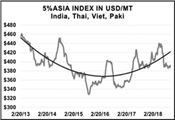|
Can We Export The 2018 Crop?
MILO HAMILTON
AUSTIN, TEXAS
Some cringe at every weekly export report and fear that stocks of long grain will pile up this season and the price will hang low. I am not of that persuasion, even if the trade disputes remain at high tension into 2019 planting season. Of course, if bean prices languish in the $7 per bushel region, then more rice acres could be planted in the south, breaking an up-then-down pattern of the last few years. Where will we sell all our surplus rice? You need not wring your hands right away. Whatever price weakness Father Trade gives us could be offset by Mother Nature with a smaller crop in South America or somewhere else on this planet moving into a 200-400 year low in the cycle of sunspots. Those who are blessed with a good crop in the years ahead may be feeding a lot who are less fortunate because of chance location of their farm.
The year 2019 is not so negative on price to me, whatever happens to the bean price or Asian rice prices. The key sleeper here is very tight stocks in the major competitor to the US, South America, and any damage done before harvest to that crop down under.
Here are terms about world weather you need to keep top of mind: Sunspot minimums, arctic blocking and El Nino. All or any of these factors can cut production of rice or wheat in the next 12 months. International grain analysts assume normal weather, bad idea. Climate has predictable cycles in my humble opinion.
If demand for wheat picks up, rice buyers will step up their buying. That happens almost like clockwork. Perhaps Russia will have banned wheat exports by January. Russia is doing in wheat what Brazil did in rice in the first half of 2018: selling out its food grains like there will be no demand tomorrow.
Asian prices are moving higher year by year and stocks in major exporter hands, lower year by year since 2013. The recent price dip is far below the upward curving trend. I know China claims a lot of rice in stock; and their philosophy is “full bins make for a tranquil price.” That is true as long as the stats are real and not fabricated. And the rice pile is edible, especially by humans.
In any case, normally the Asian rice market bottoms by November, just like in the US. Its biggest crop, the weight of the main crop, comes off in most places about the same time as Arkansas.
The financial wild card is the stock market and the US dollar that may take some drubbing before we meet in January. But a weak dollar covers a host of sins, particularly in Brazil, where politics could nudge their currency higher. Recession often leads to more not less rice demand.
We have a rice price which is treading water but cannot stand still long if there is a bull market in wheat. Markets are moody creatures and a rising dollar makes buyers buy hand to mouth. A weak dollar does the opposite.
Our work indicates that by January 2019, we will get a major and long-term buy signal in the food grains. We developed this indicator many years ago, when we were buying over $100 million of rice each year. It will be the first buy signal for our indicator since 2002. We used to get these signals about every four years, but the world is richer now than it was even in 2002 and can lavish a $100 billion in grain farmer subsidies in China or India.
No bull market in rice has happened, except 1993, without a simultaneous or previous run up in the price of wheat. It is not that rice substitutes for wheat or vice versa but just as soybean meal and corn are hooked together at the hip so are wheat and rice. Buyers have been buying hand to mouth, not just because their price outlook is bearish, but they are skittish on the stock market, world demand and deteriorating world trade. Uncertainty puts lows in early not late.
Much of the ground rules for world grain trade hinged on variables that have come loose. Uncertainty about supply does not trigger buying unless someone makes a move first. The first move could come from Mother Nature and/or Uncle Sam’s dollar.
Looking forward to seeing you all in Baton Rouge at the Crowne Plaza In 2019. It is a testimony to the uncertainty of ag markets now that a lot can transpire to alter our outlook for 2019 prices stated here in this short piece; but it is hard for me to see what can send rice prices lower and a lot of developments can send them higher. I like those kind of odds. Expect growing volatility over the next few years. Opportunities are always hidden inside volatility. ∆
Milo Hamilton is President and Co-founder of the rice market advisory service, The Firstgrain Rice Market Strategist. He has extensive background buying and selling rice from 1981-1999. He established Firstgrain, Inc. in 2000. He has clients from farmers to rice processors, brokers and traders to international concerns involved in human and pet food rice products. With his business partner, Kevin Ries, Milo publishes the online service, www.firstgrain.com that is read by buyers and sellers around the world. His company, Firstgrain, Inc. is focused on rice and believes that “every individual is a market force.” The name, Firstgrain, comes from a Chinese proverb, “The precious things are not pearls and jade but the five grains, of which rice is first.” His email address is: milo@firstgrain.com.

|
|